How to Cite | Publication History | PlumX Article Matrix
IoT Based Automated Saline Drip and Hand Movement Detection System for Critical Care Patients
G Hari Krishnan1* , I Kumaraswamy1
, I Kumaraswamy1 , G Umashankar2
, G Umashankar2 , T Sudhakar3
, T Sudhakar3 , Joshini E V2, Kavitha S2 and Sandhya J2
, Joshini E V2, Kavitha S2 and Sandhya J2
1Centre for Energy, Department of Electrical and Electronics Engineering, Sree Vidyanikethan Engineering College, Mohan Babu University, Tirupati, India
2GRT Institute of Engineering and Technology, Tiruttani, India
3Sathyabama Institute of Science and Technology, Chennai, India
Corresponding Author E-mail: haris_eee@yahoo.com
DOI : http://dx.doi.org/10.13005/bbra/3044
ABSTRACT: The major goal of this project is to develop a saline drip detection and control system used to inject saline or intravenous fluids into a patient's veins. This project presents an IoT-based system to address issues such as fluid backflow, blood loss, and so on. Solution to concerns like fluid backflow and blood loss, among others. As a result, we devised the Automated Intravenous Drip Monitoring System. In this project, we utilize an Arduino-based microcontroller to manage the drop rate, detect tube obstruction, and warn the user when the drips are emptied. Here we are going to monitor the drip rate whether it is low or over, by using ultrasonic sensor. By using the MEMS motion sensor, we can also detect the patient's movement while taking drips after they have undergone some surgery or in ICU condition. In addition, we are going to estimate the possibilities of blood clotting in the veins of the patient. If motion is detected in the infusion hose, the sensors will alert the doctors or nurses with a buzzer and an LED light. The flow rate and infusion interruption problems were monitored by transmitting the data wirelessly via Bluetooth via their smart phones using mobile applications and computer-based applications. As a result, at the nurse's station, the developing system can closely monitor the drip infusion situation of numerous patients.
KEYWORDS: IoT; Arduino; Buzzer; IV drips; MEMS sensor; Ultrasonic sensor
Download this article as:| Copy the following to cite this article: Krishnan G. H, Kumaraswamy I, Umashankar G, Sudhakar T, Joshini E. V, Kavitha S, Sandhya J. IoT Based Automated Saline Drip and Hand Movement Detection System for Critical Care Patients . Biosci Biotech Res Asia 2022;19(4). |
| Copy the following to cite this URL: Krishnan G. H, Kumaraswamy I, Umashankar G, Sudhakar T, Joshini E. V, Kavitha S, Sandhya J. IoT Based Automated Saline Drip and Hand Movement Detection System for Critical Care Patients . Biosci Biotech Res Asia 2022;19(4). Available from: https://bit.ly/3uLkPnJ |
Introduction
IoT based system facilitates the incorporation of the physical environment into a computer-based system 1,2. IoT makes things easier by automating daily processes, resulting in a higher quality of life while also saving money and time 3,4. In general, as population density rises, so does the importance of health care 5,6. As a result, it is imperative that everyone in the world takes adequate care of their health 7. The Internet of Things (IoT) plays a significant role in the health-monitoring system 8,9. We can integrate this technology into hospital management systems by adding intelligent devices and subsystems, allowing hospitals to save money on operations, improve patient care, and minimize medical staff capital and labour intensity 10,11.
Many automated health monitoring gadgets have been developed in recent years to ensure patient safety while also reducing medical staff stress 12,13. In this proposed work, a monitoring system for automatic control of liquid level with the help of the Internet of things is used to control flow rate manually using a mobile app, monitor IV fluid level in the bag and provide warning to medical personnel to change the bag, and also a monitoring system for automatic control of liquid level with the help of the Internet of things is used to control flow rate manually using a mobile app (IoT) 14,15. A Bluetooth module was used to detect the infusion rate and empty infusion in a remote drip infusion device 16,17.
In our proposed system, we are going to control the drip flow manually and provide warning for low drips and over dose. Here we are going to monitor the drip rate whether it is low or over by using ultrasonic sensors 18,19,20. We are also going to capture the patient’s movement while are taking drips after they have undergone some surgery or in critical conditions by using MEMS sensors and transmitting data via Bluetooth wirelessly using IOT 21,22. We employ a buzzer system and a messaging system for our alert system. If the patient is uncomfortable or if any abrupt changes occur, an alert will be sent to the doctor’s or nurse’s station 23, 24.
MEMS Sensor
Micro Electromechanical system sensor is a capacitive plate IC technology used for measurement of movement, pressure etc. Mechanical movement creates a potential difference due to changes in capacitance between plates. Patient hand movement was detected using MEMS sensors in our proposed research.
Arduino Uno Board & Arduino IDE Software
The Arduino Uno is an Embedded board with ATmega328p microcontroller as a processing unit. MEMS, Ultrasonic sensor and other actuators are connected to the digital and analogue pins of Arduino Uno board. The information received from the sensor is processed and displayed in 16×2 LCD seven segment using Uno board. Features like GPIO (General Purpose Input & Output) for connecting Sensor and actuators, PWM (Pulse Width Modulation) for the control of actuators and ADC (Analog to Digital Converter) for analogue sensor input are inbuilt into the Arduino Uno Board.
Power supply and programming for Arduino Uno was done through a personal computer. Arduino Integrated Developer Environment (IDE) was installed in PC to program, debug and upload to the ROM of Arduino Uno Board. Sensor data was posted into the cloud using the Node MCU Wi-Fi module by configuring Wi-Fi authentication data and API key generated using Ubidot app. Sensor data was visualized in the cloud using the IoT Ubidot app.
Block Diagram of Proposed System
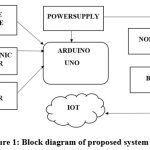 |
Figure 1: Block diagram of proposed system. |
The block diagram of the saline monitoring system as shown in figure1. The essential flow of the system architecture is depicted in the diagram above 25,26. IoT devices can capture all data from the patient’s body via sensors and wirelessly communicate that data to mobile or computer-based applications [27] [28]. The applications are where the real-time system can monitor and analyse all of the data via a mobile app. The fluid level can be measured with an ultrasonic sensor. The medical station will be notified if the fluid level reaches an empty state 29,30. The patient’s movement can be monitored by using the MEMS sensor. Either a doctor or nurses can control the flow rate and the patient’s movement by analysing the fluid status 31. For the alert system, we provide a Buzzer facility that converts audio signals into sound signals. Finally, if the medical team is too far away from the patient, an alert message will be sent to the mobile app.
IoT devices can collect data from consumers via wi-fi, Bluetooth, or any other online platform. Data such as fluid levels and patient mobility can be tracked to help the patient avoid a heart attack or a stroke at an early stage. By using a mobile app, the data collected from the patient can be displayed to mobile applications. As a result, we designed the system to be a real-time monitor. The Arduino IDE is a free, open-source software package that enables users to develop and upload code in a real-time environment. Because this code will be saved in the cloud, it is frequently used by individuals looking for an additional level of redundancy. Any Arduino software board is entirely compatible with the system. Node MCU is an opensource platform based on the ESP8266 that uses the wi-fi protocol to link things and send data. Furthermore, by demonstrating some of the most important functionalities of microcontrollers, such as GPIO, PWM, ADC, and so on.
Results and Discussion
Simulation Output
We are using ISIS Proteus Design Suite in our work, which is a software solution particularly for electronic design automation. First, we do a circuit design of the LCD connected with the Arduino uno on the transmitter side and sensors such as ultrasonic, flow& MEMS sensors are placed with the battery sources connected to the Arduino pins and the program codes are written and compiled on Arduino IDE. The output will be displayed in Lcd or serial monitor with the values and the LED will glow when we are going to increasing the sensor values and it turns off if values decrease. The simulation output of the control circuit is as shown in figure 2 and figure 3.
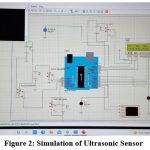 |
Figure 2: Simulation of Ultrasonic Sensor. |
Ultrasonic sensor
If we are going to increases value of the ultrasonic sensor the 1st blue LED will glow and displayed in LCD denoted as S1 with the value 1023.
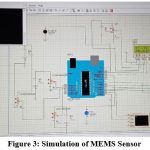 |
Figure 3: Simulation of MEMS Sensor. |
MEMS sensor
If we are going to increases value of the ultrasonic sensor the 2nd blue LED will glow and displayed in LCD denoted as S2 with the value 1023.
Hardware Output
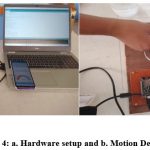 |
Figure 4: a. Hardware setup and b. Motion Detection. |
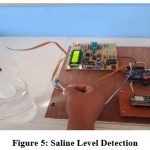 |
Figure 5: Saline Level Detection. |
The figure shown in 4 (a and b) and figure 5 the final output of the saline monitoring system here we are connecting the sensors such as Ultrasonic water level sensor and MEMS sensor to the Arduino UNO which is used to detect the saline level and also patient irregular movements while injecting drips into their veins. The Arduino code will be complied on the Arduino IDE software to run the real time applications. The collected data will be transmitted via mobile app such as Ubidots for acquiring the patient data and transmitting those data’s to tha nurse or doctors’ station in the hospital.
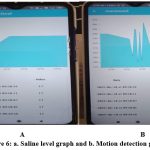 |
Figure 6: a. Saline level graph and b. Motion detection graph. |
The figure 6 (a and b) shows the graph of the saline level. It can be displayed in the Ubidots app and the graph changes according to the saline level. If the saline level comes to 17 the buzzer will provide warning through alarm to the medical station in the hospital. The figure 10. shows the graph of the movement detection in patients. It can be displayed in the Ubidots app and the graph changes according to the irregular movements occurs in patient. If the angle reaches up to 400 the buzzer will provide warning through alarm to the medical station in the hospital.
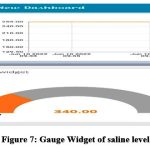 |
Figure 7: Gauge Widget of saline level. |
The figure 7 shows the Gauge widget of the saline level can be used to indicate the status of the entire drips monitoring system.
TABLE 1. Readings Of Ultrasonic Sensor
|
Ultrasound level |
Saline level |
Buzzer Alertness |
|
5 |
100 |
– |
|
6 |
150 |
– |
|
8 |
200 |
– |
|
9 |
250 |
– |
|
11 |
300 |
– |
|
12 |
350 |
– |
|
14 |
400 |
– |
|
Above 15 |
Above 450 |
yes |
Table 2: Readings Of Mems Sensor
|
Angle
|
MEMS value (Movement) |
Buzzer Alertness |
|
0 degree |
340 |
No |
|
30 degrees |
343 |
Yes |
|
60 degrees |
345 |
Yes |
|
90 degrees |
400 |
Yes |
|
120 degrees |
345 |
Yes |
|
150 degrees |
393 |
Yes |
|
180 degrees |
397 |
Yes |
Discussion
The system’s final output is depicted in the table 1 and 2. In order to obtain data such as fluid level and patient movement in critical scenarios such as coma or ICU while injecting saline into the veins, we designed hardware such as an Arduino embedded with a sensor. The detected data is visually shown on an Android app with the drip system via a mobile app or computer-based programmers. All of the collected data is transferred to a secure cloud and is accessible via an Android app from anywhere in the hospital. The overall goal of this project is to create an Android application that displays drip level notifications and is easy to use for observers or nurses. We employ a buzzer system and a messaging system for our alert system. If the patient is uncomfortable or if any abrupt changes occur, an alert will be sent to the doctor’s or nurse’s station.
Conclusion
This method is useful in monitoring the IV solution level in hospital patients, and the data may be evaluated at the hospital’s doctor’s or nurses’ station. Therefore, the flow rate and infusion interruption problems were monitored successfully and transmitted those data wirelessly via mobile and smart phone applications. Existing open loop system for saline drip monitoring without feedback of drip disconnection due to patient unaware hand movement was replaced with our proposed system. According to this system it is also detecting the movement of the patients after injecting the saline in case of any movement is detected immediately the alarm system starts to sound and also Led starts to glow. Monitor the drips flow rate in the veins of the patient before and after injecting the saline. The proposed model will be able to closely monitor the infusion status of multiple patients in crucial situations. In this proposed system this is used to monitor three major things in a single parameter. The system is applicable for hand saline drip only, with few hardware modifications in future it can be useful for saline drip in any place on the body surface.
Acknowledgement
The authors acknowledge Centre for Energy, Department of Electrical and Electronics Engineering, Sree Vidyanikethan Engineering, Department of Biomedical Engineering, GRT Institute of Engineering and Technology, Department of Biomedical Engineering, Sathyabama Institute of Science and Technology for providing facilities to carry out research.
Conflict of Interest
All authors have no conflict of interest including honorarium, grants, membership, employment, ownership of stock or any other interest or non‐financial interest such as personal or professional relation, affiliation and knowledge of the research topic.
Funding Source
No fundings received for the proposed work.
References
- Ramisha Rani K, Shabana N, Tanmayee P, Loganathan S, Dr. Velmathi G. Smart Drip Infusion Monitoring System for Instant Alert Through nRF24L01. International Conference on Nextgen Electronic Technologies, 2017; pp.452-455.
CrossRef - Sincy Joseph, Ms Navya Francis, Ms. Anju John. Intravenous Drip monitoring system for smart hospital using IoT. International Conference on intelligent computing, 2019; pp.835-839.
CrossRef - Raghavendra B, Vijayalakshmi K, Manish Arora. Intravenous Drip Meter Controller Need Analysis and Conceptual Design. COMSNETS 2016; pp.1-5.
CrossRef - Hidekuni Ogawa, Hiromichi Maki, Sosuke Tsukamoto, Yoshiharu Yonezawa. A new drip infusion solution monitoring system with a free- flow detection function. 32nd Annual International Conference of the IEEE EMBS Buenos Aires. 2010; pp.1214-1217.
- Prikshit Verma et al, “Conceptual design of intravenous fluids level monitoring system a review”, IOP Conf. Ser.: Mater. Sci. Eng. 2017; 263; pp.1-6.
CrossRef - Wang, B. Li, and D. Qian, “Infusion Monitoring System Based on Wireless Transmission.”, IEEE International Symposium on Microwave, Antenna, propagation, and EMC Technologies for Wireless Communications. 2012; pp. 656-659.
CrossRef - Arjun Udayan, Sharook.H, C. Jeyanthi. “A Survey on automatic flow control in drip” published in IJAREEIE. 2016; 5; pp.120-126.
- Hikaru Amano, Sosuke Tsukamato, W.Mortan Caldwell. “A remote drip infusion system employing Bluetooth”. IEEE in Medicine Biology and Society. 2012; pp.2029-2032.
CrossRef - Satwik Tanwar, Deepa.K, Riddi Maniktalia. “An IoT based intravenous Drip Monitoring System”. International Journal of Science and Research (IJSR). 2021; 1299; pp.6-38.
- A. Aristov, E.V. Zhooglo, “Estimation of Blood clotting in drip sampes using Optical method. International Conference on Mechanical Engineering, Automation and Control Systems (MEACS). 2014; pp.1-4.
CrossRef - Catarinucci, D. Donno, L. Mainetti, L. Palano, L.Patrono, M.L.Stefanizzi, and L. Tarricone. “An IoTAware Architecture for Smart Healthcare Systems”, IEEE Internet of Things Journal, 2(6): 515-526,2015.
CrossRef - Noor, M. Swaied, M. AlMesned and N. AlMuzini. “A Method to Detect Object’s Width with Ultrasonic Sensor,” International Conference on Computing, Electronics & Communications Engineering (ICCECE). 2018; pp.266-271.
CrossRef - N. Ibrahim, M. S. L. Hakim, A. L. Asnawi and N. A. Malik. “Automated Water Tank Filtration System Using LDR Sensor,” 2016 International Conference on Computer and Communication Engineering (ICCCE). 2016; pp.195-199.
CrossRef - Sudhakar, G. Hari Krishnan, N. R. Krishnamoorthy, B. Janney J, M. Pradeepa and J. P. Raghavi. “Sleep Disorder Diagnosis using EEG based Deep Learning Techniques,” 2021 Seventh International conference on Bio Signals, Images, and Instrumentation (ICBSII), 2021, pp. 1-4.
CrossRef - Santhosh S, Juliet V, Krishnan G. H. “Impact of Electrodes Separation Distance on Bio-Impedance Diagnosis”. Biomed Pharmacol J. 2021; 14(1); pp.141-146.
CrossRef - Santhosh, S., Juliet, A.V. & Krishnan, G.H. “Predictive analysis of identification and disease condition monitoring using bioimpedance data”. J Ambient Intell Human Comput 2021; 12, pp.2955–2963.
CrossRef - Sudhakar, G. Hari Krishnan, G Umashankar, Sindu Divakaran, U. Bhurnima and B. Shanchita, “Drug Retrieving System in Hospitals Using Robotics”, Biomedical and Pharmacology Journal. 2020; 3(3); pp.1239-1244.
CrossRef - Santhosh, S., Vimala Juliet, A., Hari Krishnan, G. “Simulation of Signal Generation and Measuring Circuit and Real Time IoT-Based Electrical Bio Impedance Cardiac Monitoring System”. Intelligent Computing, Information and Control Systems. ICICCS 2019. Advances in Intelligent Systems and Computing. 2020; 1039; pp.1-5.
CrossRef - Sheeba Santhosh, A. Vimala Juliet, G. Hari Krishnan. “Bio Impedance Signal Analysis with Variation in Input Signal Frequency”. International Journal of Advanced Trends in Computer Science and Engineering, 2020; 9(4); pp.5332-4336.
CrossRef - Mohandass, G., Ananda Natarajan, R., Hari Krishnan, G. “Comparative analysis of optical coherence tomography retinal image using multidimensional and cluster methods”. Biomedical Research (India), 2015; 26(2); pp.273-285.
- Hemalatha, R.J., Krishnan, G.H., Umashankar, G., Abraham, S. “Computerized breast cancer detection system”. Biosciences Biotechnology Research Asia. 2014; 11(2); pp.907-910.
CrossRef - Krishnan, G.H, Natarajan, R.A., Nanda, A. “Comparative study of rheumatoid arthritis diagnosis using two different methods”. Biomedical and Pharmacology Journal. 2014; 7(1); pp.379–382.
CrossRef - Krishnan, G.H, Nanda, A., Natarajan, A. “Synovial fluid density measurement for diagnosis of arthritis”. Biomedical and Pharmacology Journal, 2014; 7(1); pp.221–224.
CrossRef - Hari Krishnan, G.H., Ananda Natarajan, R., Nanda, A. “Impact of upper limb joint fluid variation on inflammatory diseases diagnosis”. Journal of Electrical Engineering and Technology, 2014; 9(6); 2114–2117.
CrossRef - Hari Krishnan, G., Hemalatha, R.J., Umashankar, G., Ahmed, N., Nayak, S.R., “Development of Magnetic Control System for Electric Wheel Chair Using Tongue”. Advances in Intelligent Systems and Computing 308 AISC (VOLUME 1). 2015; pp.635-641.
CrossRef - Guru Anand, V., Hari Krishna, G., Mohandass, G., Hemalatha, R.J., Sundaram, S. “Predicting grade of prostate cancer using image analysis software.” Proceedings of the 2nd International Conference on Trendz in Informtion Sciences and Computing, TISC-2010, 2010; pp. 122–124.
CrossRef - Ilangovan, N., Hari Krishnan, G. “Wheel chair movement control using human input: Comparative study approach”. Research Journal of Pharmaceutical, Biological and Chemical Sciences, 2015; 6(3), pp.568-570.
- Krishnan, G.H., Natarajan, R.A., Nanda, A. “Microcontroller based noninvasive diagnosis of knee joint diseases”. International Conference on Information Communication and Embedded Systems, ICICES 2014, 2015; pp.1-5.
CrossRef - Nagarjuna Reddy, A., Hari Krishnan, G., Raghuram, D., “Real time patient health monitoring using raspberry PI, Research Journal of Pharmaceutical”, Biological and Chemical Sciences, 2016, pp.7(6); pp.570-575.
- Hari Krishnan, G., Umashankar, G., Abraham, S., “Cerebrovascular disorder diagnosis using MR angiography”, Biomedical Research (India), 2016; 27(3); pp.773-775.
- Hari Krishnan, G., Abhinaya, N., Hemalatha, R.J., Mohandass, G., “Hardware implementation for feedback control-based health monitoring and drug delivery”, Biomedicine (India), 2017; 37(1); pp.123-126.

This work is licensed under a Creative Commons Attribution 4.0 International License.





